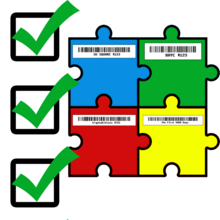The topic of this article may not meet Wikipedia's general notability guideline. (December 2023) |
| ERC-721: Non-Fungible Token Standard | |
 ERC-721 illustrated with checkmarks and puzzle pieces representing standardized properties, compatibility and non-fungibility | |
| Year started | 2017 |
|---|---|
| First published | 2018 |
| Series | Ethereum Improvement Proposals (EIP) |
| Authors | William Entriken, Dieter Shirley, Jacob Evans, Nastassia Sachs |
| Predecessor | ERC-20 |
| Domain | NFTs |
| Copyright | Creative Commons CC0 |
| Website | eips |
The ERC-721 Non-fungible Token Standard is a technical framework, defining a set of rules and interfaces for creating and managing unique, non-fungible tokens (NFTs) on the Ethereum blockchain.[1][2][3] ERC-721 is recognized for formalizing the concept of an NFT and establishing the foundation of the multi-billion dollar digital collectibles ecosystem that emerged alongside its adoption. It is one of the most widely used NFT standards across use cases and has been utilized in various high profile projects.
The development of the standard was a community-driven effort that was formally published into a paper of the same name in 2018 and is accredited to William Entriken and co-authors Dieter Shirley, Jacob Evans, and Nastassia Sachs. ERC stands for "Ethereum Request for Comments," and is a part of the Ethereum community's peer-review process in which new proposals are considered for publication; the "721" is a unique identifier, each proposal is assigned one arbitrarily after an editor approves it in the draft phase.[4][5] The blockchain game featuring digital cat artworks known as CryptoKitties is credited with pioneering ERC-721 when it achieved mainstream attention shortly after its launch in 2017.[6] [1]
- ^ a b Bamakan, Seyed Mojtaba Hosseini; Nezhadsistani, Nasim; Bodaghi, Omid; Qu, Qiang (2022-02-09). "Patents and intellectual property assets as non-fungible tokens; key technologies and challenges". Scientific Reports. 12 (1): 2178. arXiv:2304.10490. Bibcode:2022NatSR..12.2178B. doi:10.1038/s41598-022-05920-6. ISSN 2045-2322. PMC 8828876. PMID 35140251.
- ^ Chandra, Yanto (2022-11-01). "Non-fungible token-enabled entrepreneurship: A conceptual framework". Journal of Business Venturing Insights. 18: e00323. doi:10.1016/j.jbvi.2022.e00323. ISSN 2352-6734. S2CID 248958972.
- ^ "Why People Are Paying Big Money For Virtual Real Estate in the Metaverse". Time. 2022-01-20. Retrieved 2023-12-03.
- ^ "EIP-1: EIP Purpose and Guidelines". Retrieved 2023-11-20.
- ^ Anett (2021-08-08). "What the heck is EIP and how can I create one ? Ethereum Standards EIP ERC FAQs". Retrieved 2023-11-20.
- ^ Lindman, Kyle Wood and Taylor (2018-08-21). "Why the next CryptoKitties mania won't be about collectables". TechCrunch. Retrieved 2023-12-03.